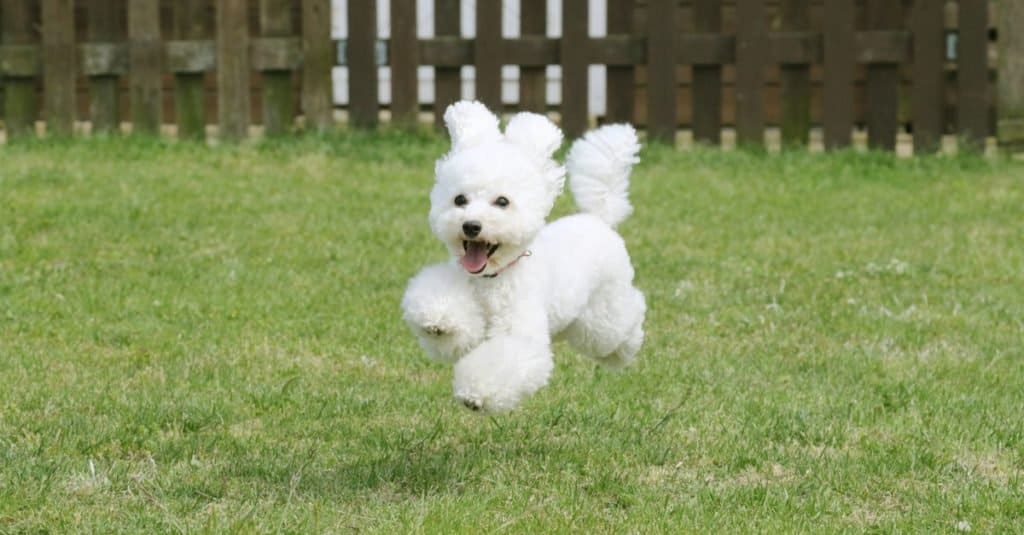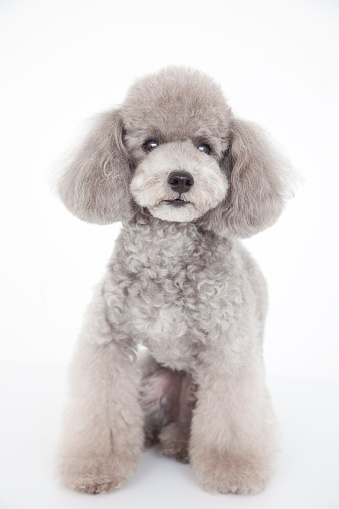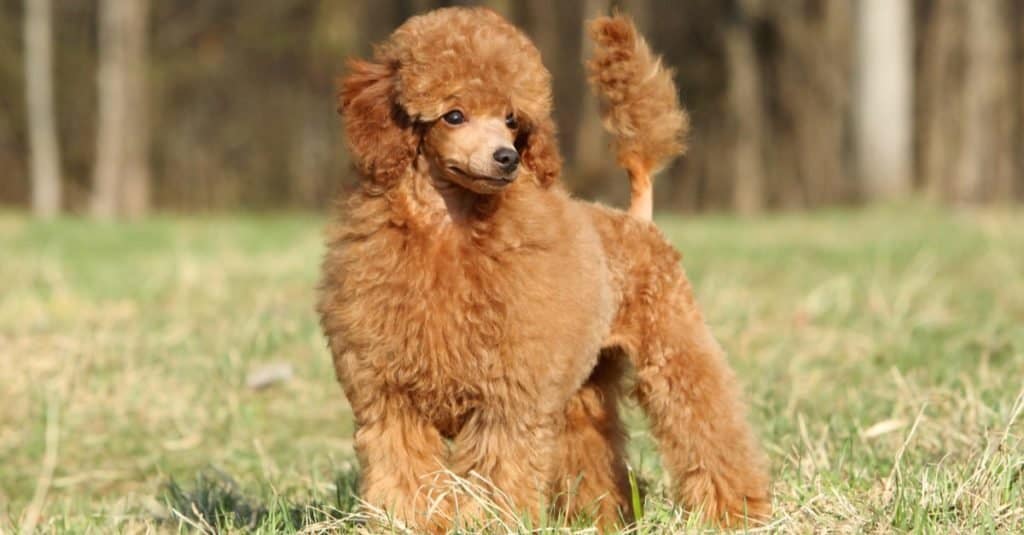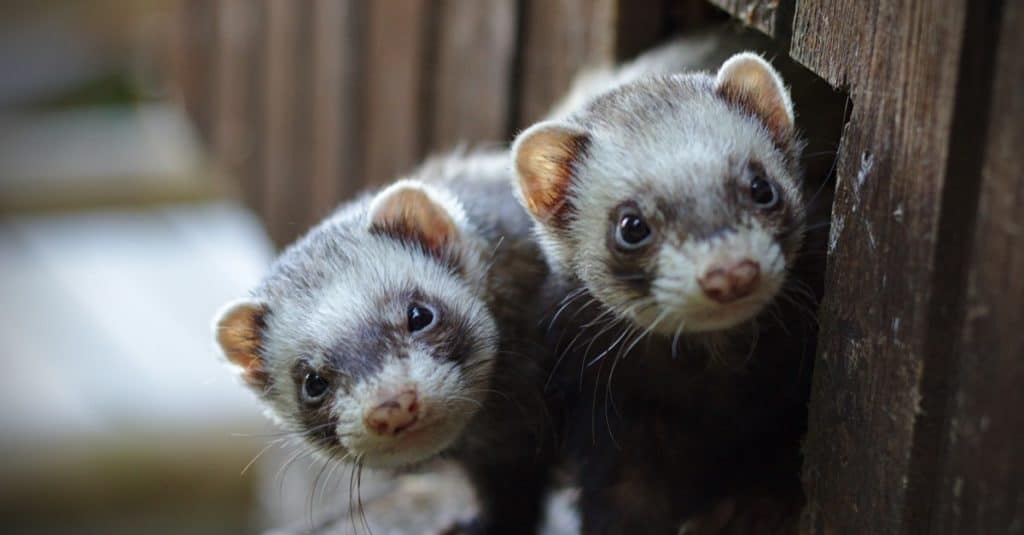When most people think about Toy Poodles, they might immediately associate the breed with a pocket purse stereotype. So, it might surprise you that toy poodles are, in fact, a fascinating breed with many intricacies. They may be tiny, but they certainly have enormous personalities! Here are 10 incredible Toy Poodle facts that might surprise you.

1. Cute, Fluffy, and Hypoallergenic

Toy Poodles have fur that is the most hypoallergenic of all dog breeds.
©Lim Tiaw Leong/Shutterstock.com
Did you know that Toy Poodles are the most hypoallergic of all coated dog breeds? Contrary to popular belief, a fluffy, woolly coat does not automatically provoke allergies. On the contrary, they are adorable with all their fluff and have the advantage of being a light shedder. So, if you are prone to allergies, one of these dogs might be the perfect pet.
2. Toy Size but Tough as Nails

Toy poodles are small but mighty.
©Rin Seiko/Shutterstock.com
Poodle breeds like this are the smallest type of poodle. They stand no more than 10 inches tall and generally only weigh about 6-10 pounds. They can come in a smaller size too. A smaller version is a Teacup Poodle.
Although diminutive in size, don’t let that fool you! These tiny dogs can be mischievous and downright fearless. Although not aggressive, these pups can nip or bite if provoked or intimidated.
3. Adorable and Incredibly Smart

Toy poodles are highly intelligent.
©paylessimages/iStock via Getty Images
Toy Poodles aren’t just all fluff! They are incredibly smart, bright dogs. Because of this super intelligence, they are easy to train. In addition, with their easy-going nature, they are highly responsive to reward-based training.
With the right combination of treats and discipline, there is very little this dog breed cannot do. They have an endearing take charge, “big dog” personality rolled into an adorable package.
4. Danger Alerting Watchdog

Toy poodles are suspicious of strangers.
©iStock.com/darak77
A small Poodle embodies the term “tiny but fierce.” They may be generally sweet and welcoming, but they are highly suspicious of strangers and the unfamiliar. A common misconception is that poodles are barkers because they are not.
In comparison to other breeds, these dogs are not very vocal. What they will do is alert you to potential danger or a suspicious person. Toys are susceptible to nuance, so the next time they bark, you may want to pay attention.
5. The Not So French Toy Poodle or “Duck Dog”

Poodles originated from Germany.
©Dulova Olga/Shutterstock.com
Many people believe that the Toy is the quintessential French breed. However, this is not entirely accurate. They are, in fact, originally from Germany.
Their story began about 400 years ago.
They were initially bred to retrieve ducks from the water during hunting. They are descendants of the Barbet water dogs, which are still reared today, and which might just explain their big dog attitude!
6. A Little More Length to A Toy Poodle Tail

European Toy Poodles have longer tails than their U.S. counterparts.
©Jagodka/Shutterstock.com
Many people, especially those in the United States, are familiar with the sight of a short, fluffy Toy tail. But this tail length is not standard as breeders typically dock their tails at just 2 or 3 days old.
This term means that breeders remove the tips of the tail. Docking will leave this dog with a tail only half to two-thirds of what it should have been originally. Tail docking is illegal in much of Europe and the United Kingdom. Europeans reserve docking for worker dogs such as retrievers and terriers. So, you might see a slightly different-looking Toy Poodle abroad.
7. Costs a Pretty Penny

Toy poodles are expensive pets.
©studio hoto/Shutterstock.com
It might shock you that such a tiny dog can be so expensive. A Toy Poodle costs around $1,894 to $3.500 per puppy. These dogs will cost a pretty penny if you want to get them from a reputable breeder. As with thoroughbreds, medical costs can also pack quite a punch.
There are plenty of other expenses you can associate with the proper care of these adorable pets. The maintenance of their coat alone will have you at a grooming shop at least once a month unless you are into doggy grooming DIY.
8. Toy Poodles Can “Talk!”

Toy poodles can speak in their own way!
©alinabuphoto/Shutterstock.com
Toy poodles can make different sounds and actions to get some attention. Although their communication behavior may not be talking in a conventional sense, they do speak with their owners in various ways. Toy Poodle owners on Poodle Forum are adamant that their dogs talk to them.
Toy Poodles are highly intelligent and can learn more than 400 different words and commands. In addition, the breed has a remarkable capacity to read body language. Because they are extremely sensitive dogs, so they can anticipate the owner’s commands even before speaking.
9. Crazy Fact – Ferrets Sold as Toy Poodles in Argentina

Ferrets were passed off as Toy Poodles.
©iStock.com/Harald Schmidt
Fake Toy Poodles shenanigans caused quite the stir in Argentina in 2012. Huffington Post reports that several “Argentinian bazaar salesmen are passing off ferrets on steroids as Toy Poodles – and people believe them.”
This unfortunate event led a few poor naïve souls to spend an exorbitant $150 per “poodle.” Huffington revealed that groomed and steroid-fed ferrets are standard practices in Argentina.
They sell them as “Brazilian rats” in popular markets. The fake Toy Poodles did cause quite a bit of uproar, where people felt they were tricked into buying a lie. Needless to say, no one is quite sure of the whereabouts of these special “Toy Poodles!”
10. Hope – The Tiniest Toy Poodle in the World
Hope was a Canadian-born Toy Poodle with dwarfism. She was the smallest dog in the world in 2013. An already tiny breed, Hope was even smaller because of her diagnosis. Hope was less than one ounce when she was born and was still only 11 ounces at the age of 4 months.
Rodney Mclean tells her heartwarming story in a YouTube video. She took the world by storm with a typical fearless Toy Poodle attitude. Sadly, Hope passed away not long after the documentary. Rodney said she had a ”rambunctious spirit and energy”, not realizing that Hope was, in fact, the tiniest dog in the world at the time.

The smallest dog in the world is a toy poodle.
©maxfoto87/iStock via Getty Images
The photo featured at the top of this post is © Rin Seiko/Shutterstock.com
Ready to discover the top 10 cutest dog breeds in the entire world?
How about the fastest dogs, the largest dogs and those that are -- quite frankly -- just the kindest dogs on the planet? Each day, AZ Animals sends out lists just like this to our thousands of email subscribers. And the best part? It's FREE. Join today by entering your email below.
Thank you for reading! Have some feedback for us? Contact the AZ Animals editorial team.







